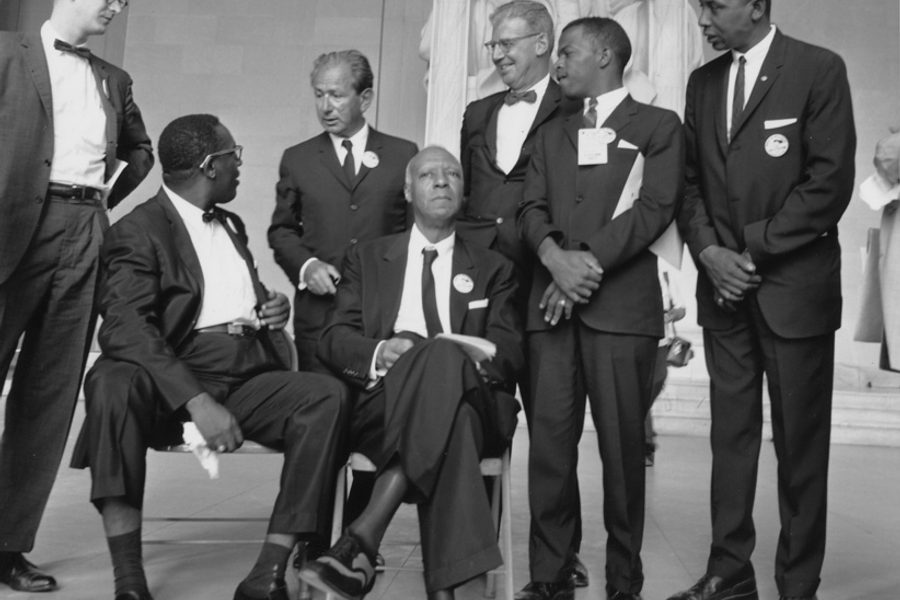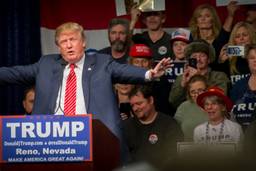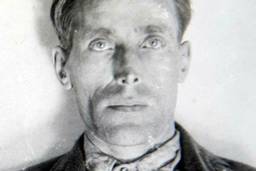The Lessons of A. Philip Randolph’s Life for Racial Justice and Labor Activists Today
David Cochran

By late 1940, the United States finally was pulling out of the Great Depression. American entry into World War II was still a year away, but the war in Europe led to increased American military spending, fueling economic growth and new jobs. But economic recovery might as well have been marked “Whites Only,” as defense industries refused to hire black workers. For most African Americans, the war did not mean the end of the Depression.
Enter A. Philip Randolph.
Randolph had first established himself as an influential Harlem Renaissance intellectual when he and Chandler Owen began publishing the socialist journal The Messenger in 1917. At a time when most black intellectuals, notably W.E.B. DuBois, were encouraging African Americans to support U.S. entry into the war, The Messenger took a staunch anti-war position — prompting Attorney General A. Mitchell Palmer to call it “by long odds, the most able and dangerous of all the Negro publications.”
In 1925, Randolph began organizing African-American railroad porters into a union. Following a 12-year struggle, the Brotherhood of Sleeping Car Porters (BSCP) established itself as the largest black labor union in the country, and Randolph had become the country’s preeminent black labor leader.
In January 1941, Randolph announced the formation of the March on Washington Movement (MOWM), calling for 10,000 blacks to hold a rally on July 1 at the Lincoln Memorial demanding President Roosevelt issue an executive order abolishing discrimination in national defense jobs and ending Jim Crow in the military. The appeal resonated with rank-and-file black workers. By early summer, Randolph announced the number of expected participants had risen to 100,000.
“You possess power, great power,” he told his followers. “Our problem is to harness and hitch it up for action on the broadest scale.”
Roosevelt was desperate to avoid the march. But Randolph was not going to cancel without an acceptable quid pro quo. On June 25, the two sides reached a deal: Randolph called off the march; in exchange, Roosevelt issued Executive Order 8802, prohibiting discrimination in employment in defense industries and establishing a Fair Employment Practices Committee (FEPC). Randolph and black workers did not get all they sought — the FEPC was largely powerless and the military remained segregated — but 2 million blacks eventually found employment in wartime defense work and African Americans largely joined the broader economic recovery.
Randolph built on the precedent of the MOWM. In 1948 he announced a campaign of civil disobedience and draft resistance, pressuring President Harry Truman to issue an executive order ending Jim Crow in the military. And in 1963, he organized the March on Washington for Jobs and Freedom to pressure President John Kennedy to introduce meaningful civil rights legislation.
According to Clarence Lang, chair of the African and African-American Studies Department at the University of Kansas, “whether you hate him or love him, you cannot get around Randolph if you’re looking at black labor in the twentieth century in the United States.”
For the 75th anniversary of the original March on Washington, I spoke with Lang about the origins, impact and legacy of the March on Washington Movement. Lang is the co-editor (with Andrew Kersten) of Reframing Randolph: Labor, Black Freedom, and the Legacies of A. Philip Randolph.
What sorts of strategies did Randolph develop during the struggle to organize the Brotherhood of Sleeping Car Porters?
Randolph understood the need to embed this struggling union in the daily lives of black communities. So he relied on civic networks, many of them led by women, who helped to support the porters as they attempted to organize. That wasn’t easy, because the Pullman Company was a patron of black community institutions itself. For example, the company often paid for ads in the black press as a way of buying their support. So the union had to fight the black press.
So it’s not just that the union had to fight the Pullman Company — which they certainly did — but they also had to wage that battle ideologically within the black community for a particular vision around black people having the right to collectively bargain with their employers. The specific networks were crucial and particularly these women-led networks that the BSCP drew from.
Wasn’t a lot of this ideology framed in terms of “black manhood”?
That’s right. He pursued a relationship with the American Federation of Labor, which was craft-oriented and rooted in ideas of white manhood. Randolph believed that for this struggling union to have any hope, it had to have some kind of relationship with the house of labor, so he was willing to make all kinds of concessions to the AFL.
To complicate things even a bit more, when the BSCP was first formed, it was called the Brotherhood of Sleeping Car Porters and Maids. One of the concessions the union made to the AFL for the sake of having standing in the organization is that they essentially dropped the maids from the picture. So it became about black men as breadwinners and women’s ideal status was as the wives of black male breadwinners. And so the proper role of black women became as wives, but not as themselves laborers in need of being organized. The idea was that if these black men are well-employed and well-paid, that would benefit black women as dependents. That was in line with the ideas of labor as manliness that prevailed in the AFL.
Now let me be clear: I’m not saying that Randolph and others did not have their own proclivities toward sexism and gender discrimination. I don’t want to blame this strictly on the AFL. I am saying, though, that in pursuing this relationship with the AFL, it lent itself to a very open exclusion of black women being recognized as laborers in their own right.
The irony is that even though in public life Randolph tended to regard women as political subordinates, he benefited heavily from the organizing skills and fundraising acumen of black women. This extended even into his personal life. His spouse, Lucille Campbell Green, was a beauty parlor entrepreneur who supported him financially through his lean years as an organizer.
How did Randolph negotiate his way through the complicated political scene of the 1930s to become the black labor leader?
One of the things that rushed Randolph into the political stratosphere was that the Brotherhood of Sleeping Car Porters was the first all-black union to negotiate a contract with a major U.S. corporation, the Pullman Company. That was historic and made him the foremost black labor and civil rights leader. Randolph was always very clear that the status of black labor was tied to the status of the black community as a whole. His argument was that insofar as black labor can be organized and made strong, it could be a vehicle for pursuing and maintaining full citizenship for African Americans across the board.
Of course, that didn’t always make him popular. But again, Randolph was very smart about building these broad networks of mutual support, and so even though there was rivalry between Randolph’s activities and those, for example, of the NAACP, he was able to figure out ways to work with these folks.
As for the Communist Party, Randolph had been an early supporter of the Bolshevik Revolution. By the early 1920s, though, he had become a virulent anti-communist — in part because he felt the CP was a secretive organization that moved to capture rather than work with groups. And his idea was that socialism could be obtained through militant, consistent reform, not through active revolutionary means.
To complicate it even further, Randolph’s argument was that because the CP was mostly white, their heavy-handedness in many organizations also took away from the ability and the space for black people to organize in their own interests. So in some ways, the March on Washington was also a response to Randolph’s criticism of the CP and its tendency, in his view, to want to capture organizations. When Randolph said the March on Washington Movement would have to be an all-black formation, that was, as much as anything else, a rebuke to the Communist Party.
Randolph’s anti-communism stemmed in part from bitter experiences he had with CP organizers. But the fact was that some of the most committed and consistent anti-racists in the trade union and civil rights movements belonged to the organized Left, many of whom had membership in the CP or ties to it. In trying to remove or isolate them from mass movements and organizing, Randolph sadly contributed to a general assault on political leftists as a whole. This affected the civil rights movement in the early Cold War by narrowing the scope of demands that could have been made. Anti-Communism also winnowed the terrain of the labor movement by destroying some of the most militant union organizations that sought to fundamentally transform society racially and economically, rather than simply secure the best bargains for their members.
What was his relationship with the Roosevelt Administration?
Randolph saw the threat of militant action not as an end in itself, but as a means of creating space to negotiate. That in some ways is the beginning of Randolph’s very interesting and long-standing relationship with the White House.
We know now that Randolph could not have gotten 10,000 black people to D.C., much less 100,000. It was a bluff. And it paid off. But the moment the Roosevelt Administration began to negotiate with him, Randolph was perfectly fine with backing off that threat.
I mention this because many rank-and-file MOWM [activists] were dead-set on making that march happen. He ultimately had to suppress the dissidents in his own ranks. Randolph much preferred the threat of militant action to militant action itself. Even though he was an amazing organizer, at some level I don’t know that Randolph ever really trusted his base. His way was always to see how one could leverage a threat to negotiate something.
What was the genesis of the March on Washington?
As we know, the policies of the New Deal, as important as they were, did not take the nation out of the Depression. It was the onset of the war and the shift to war production. The problem was that African Americans were, as had been the case in previous experience, the first fired and the last hired. So even though there were all of these labor shortages, there was resistance on the part of private employers to hiring black people in the defense industries and there was a reticence on the part of the federal government to go against that.
Using the BSCP as his political base, Randolph began to organize an effort to urge the federal government to intervene to both attack racial discrimination in the defense industries and in the U.S. military. He threatened a March on Washington that would embarrass the nation at a time when the United States was promoting itself as the arsenal of democracy and that would also disrupt war production.
As many black protestors have done in the past, he understood that this moment of crisis could be an opportunity for black people to make leaps forward in terms of their full citizenship. He threatened this march to force some kind of executive action, so Roosevelt issued Executive Order 8802 prohibiting discrimination on the basis of race, color or national origin in the defense industries. It did not address the issue of segregation in the military. That would await executive action after the war.
When Roosevelt issued that executive order, Randolph switched gears and said, “Okay, we’ve got what we needed.” And there were many people saying, “Wait a minute, we were talking about both the war industries and the military.” So Randolph, again demonstrating that he was more moderate than we often think of him, was content with that particular measure.
To be clear, Executive Order 8802 was very important. It was the first major executive order of its kind since the Emancipation Proclamation. It represented the federal government moving to become an ally — however unreliable — of demands for civil rights that continued after the war. That’s an important shift in the relationship with black protest and the federal government. And it’s important for establishing the FEPC, which functioned as a watchdog agency to monitor hiring in the defense industry. It had no sanction power, but it nonetheless created the basis upon which folks could organize and expose and shame industries that were misbehaving.
It also created the basis of MOWM committees that sprang up in cities around the nation. Those local committees became watchdogs of the defense industry. They would collect data to bring to the attention of the FEPC on behalf of black people who were denied opportunities. Far apart from anything Randolph was doing, these committees became a basis of black activism at a local level, monitoring conditions there.
And that is in some ways a more important story about black activity during the war than Randolph’s activities in New York City, as important as they were. The local organizations did some incredible things that were sometimes even more militant than what Randolph initially envisioned. His legacies in some ways are larger than what he himself did; they’re also about the organizations he created that developed a presence at the local level.
What was the long-term legacy of the MOWM?
First, as I mentioned before, it began the process of bringing the federal government into alignment with the goals of the civil rights movement; we see that blossom further after World War II. The seed was planted with the March on Washington for the relationship the movement later had with the Kennedy and Johnson administrations. It created a precedent of the federal government serving as an unreliable ally — but an ally nonetheless — with black freedom struggles. And the FEPC was an important precursor to the 1964 Civil Rights Act, which created the Equal Employment Opportunity Commission, or EEOC.
It also helped to cement the dominant form of black protest after World War II. During World War I, black people were admonished to be good citizens and unquestioning supporters of the war, with the understanding that conditions would be better after the war. That turned out to be a mistake, because the period after World War I was a very violent period for black people and for radicals of all colors and stripes.
So Randolph was one of the people who said during World War II, “We’re not going to make that mistake again”— protest would be a legitimate response and that’s how we’ll proceed. And the civil rights movement that emerged after World War II was beholden to the MOWM because the principal strategy was protest.
Now again, Randolph was willing to only go so far, because for him it was really more about the threat of militant action. But that did create a certain kind of political legitimacy for protest, and certainly at the local level, committees of the MOWM engaged in demonstrations all the time.
The third thing is that Randolph was always clear that the interests of the black community are working people’s interests and any movement of black freedom struggle for change has to proceed from that basis. That becomes a key element of the post-World War II black freedom struggle as well.
What lessons does the March on Washington hold for today’s activists?
That black people have made leaps in the United States in terms of their status when they have taken full advantage of moments of crisis, whether that crisis is war or economic depression; and black people have made the largest strides in status when they have engaged in acts of overt protest.
Also, one of the things that makes Black Lives Matter important is the goals of that movement have originated from the interests of people on the ground. If you look at the folks who have led these protests, they have not always, or even primarily, been the respectable elite. Indeed, these are people who have seen the full force of police brutality, who have prison records, who otherwise are not part of the “respectable” elements of the community.
One of the things that was most sophisticated about Randolph was that he understood you could not separate issues of race from issues of class. If we begin with the premise that most black people historically and presently are working-class people and we organize from those interests, then the goals and the needs that emanate from that activity will have an incipient impact on the conditions of working people across the board. One of the problems in the American labor movement was that the working class too often is imagined as white and located in the basic industries. But Randolph could imagine a working class that included people of color, that was female and that was not simply on the mass-production line. He had a capacious view of who composes the working class and what their interests are.
Again, he fell short of the ideal oftentimes, because he was willing to make concessions to have access to the resources and support of organized labor or the presidency. But as far as the interests of black people, he never understood them as being separate from the interests of working-class people broadly. I think in our political imagining today it’s sometimes difficult for us to have that kind of sophisticated view.






